Report on Business Operations: Environment, Functions, and Teams
VerifiedAdded on 2022/12/23
|12
|3501
|37
Report
AI Summary
This report provides a comprehensive overview of how businesses operate, encompassing various aspects of the business environment, functions, and team dynamics. It begins by describing the types of organizations found in the public and private sectors within a named country, along with an explanation of different business structures and their variations. The report then analyzes the impact of the local, national, and global economic environments on a specific business. Further, it delves into essential business functions, highlighting the importance of accounting and describing the roles of the HR department. The report explores the profit and loss account, team roles, stages of team development, motivation theories, and leadership styles. Finally, it examines the impact of customer service and the benefits of customer profiling on business success. This report offers valuable insights into key business operations and management principles.
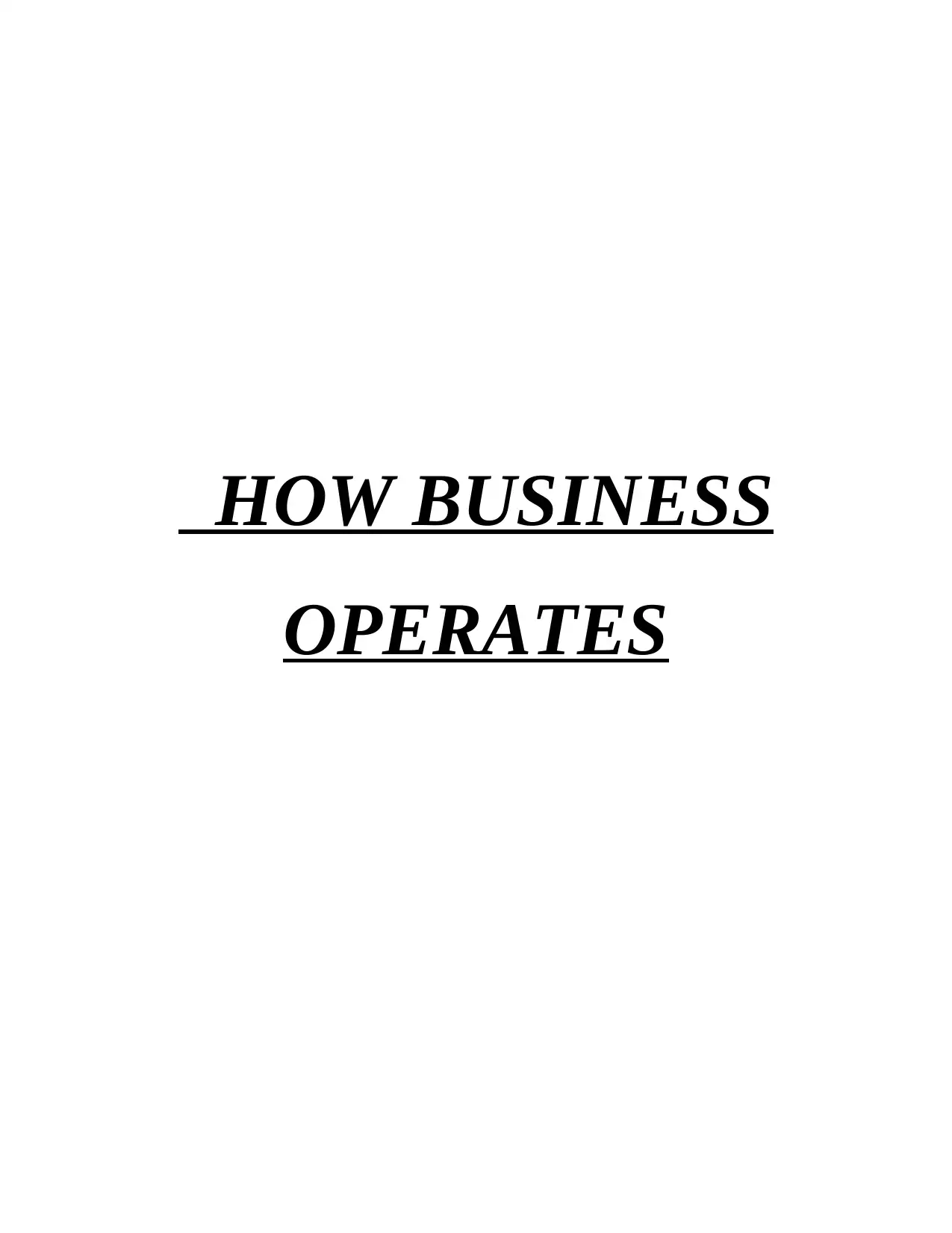
HOW BUSINESS
OPERATES
OPERATES
Paraphrase This Document
Need a fresh take? Get an instant paraphrase of this document with our AI Paraphraser
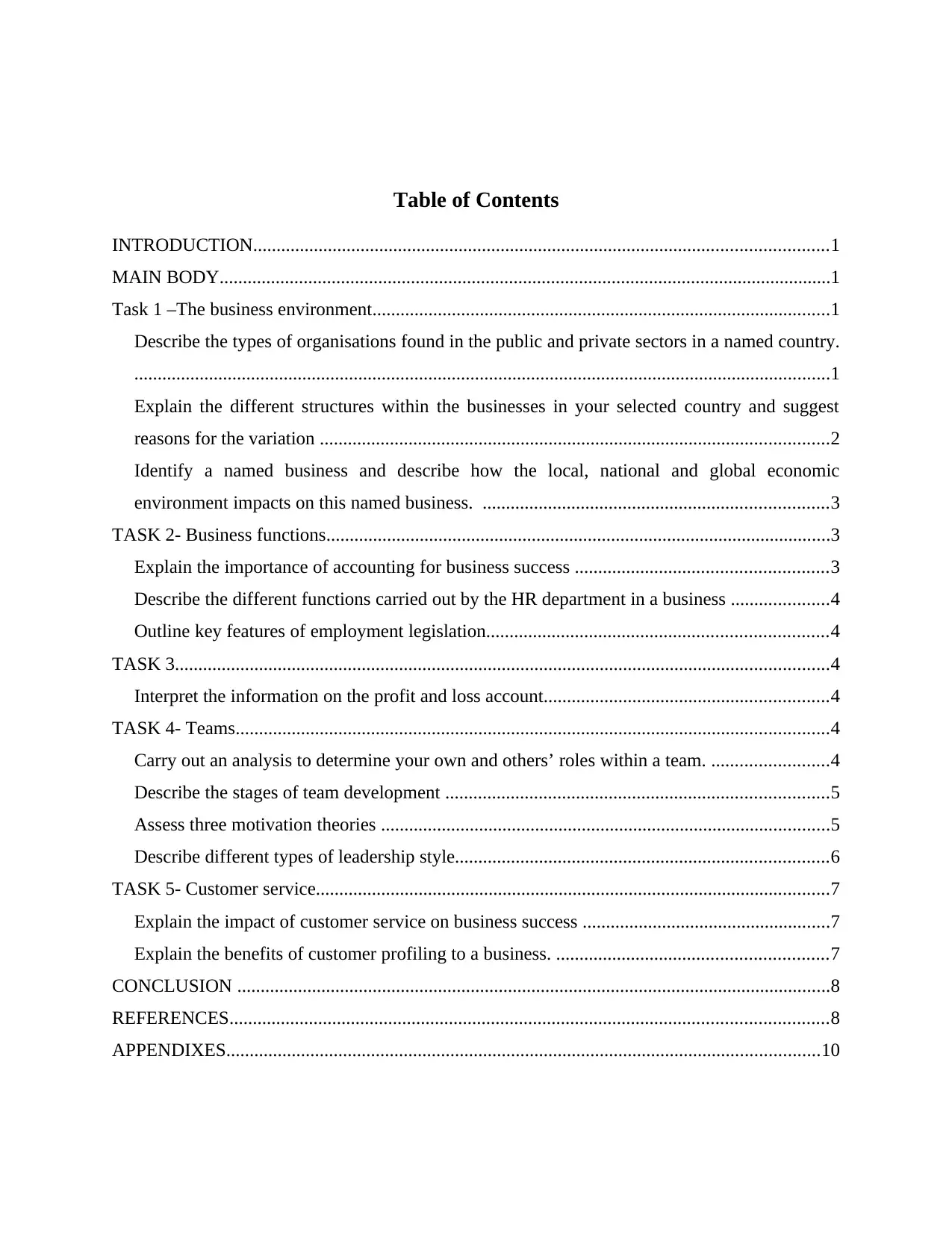
Table of Contents
INTRODUCTION...........................................................................................................................1
MAIN BODY...................................................................................................................................1
Task 1 –The business environment..................................................................................................1
Describe the types of organisations found in the public and private sectors in a named country.
.....................................................................................................................................................1
Explain the different structures within the businesses in your selected country and suggest
reasons for the variation .............................................................................................................2
Identify a named business and describe how the local, national and global economic
environment impacts on this named business. ..........................................................................3
TASK 2- Business functions............................................................................................................3
Explain the importance of accounting for business success ......................................................3
Describe the different functions carried out by the HR department in a business .....................4
Outline key features of employment legislation.........................................................................4
TASK 3............................................................................................................................................4
Interpret the information on the profit and loss account.............................................................4
TASK 4- Teams...............................................................................................................................4
Carry out an analysis to determine your own and others’ roles within a team. .........................4
Describe the stages of team development ..................................................................................5
Assess three motivation theories ................................................................................................5
Describe different types of leadership style................................................................................6
TASK 5- Customer service..............................................................................................................7
Explain the impact of customer service on business success .....................................................7
Explain the benefits of customer profiling to a business. ..........................................................7
CONCLUSION ...............................................................................................................................8
REFERENCES................................................................................................................................8
APPENDIXES...............................................................................................................................10
INTRODUCTION...........................................................................................................................1
MAIN BODY...................................................................................................................................1
Task 1 –The business environment..................................................................................................1
Describe the types of organisations found in the public and private sectors in a named country.
.....................................................................................................................................................1
Explain the different structures within the businesses in your selected country and suggest
reasons for the variation .............................................................................................................2
Identify a named business and describe how the local, national and global economic
environment impacts on this named business. ..........................................................................3
TASK 2- Business functions............................................................................................................3
Explain the importance of accounting for business success ......................................................3
Describe the different functions carried out by the HR department in a business .....................4
Outline key features of employment legislation.........................................................................4
TASK 3............................................................................................................................................4
Interpret the information on the profit and loss account.............................................................4
TASK 4- Teams...............................................................................................................................4
Carry out an analysis to determine your own and others’ roles within a team. .........................4
Describe the stages of team development ..................................................................................5
Assess three motivation theories ................................................................................................5
Describe different types of leadership style................................................................................6
TASK 5- Customer service..............................................................................................................7
Explain the impact of customer service on business success .....................................................7
Explain the benefits of customer profiling to a business. ..........................................................7
CONCLUSION ...............................................................................................................................8
REFERENCES................................................................................................................................8
APPENDIXES...............................................................................................................................10
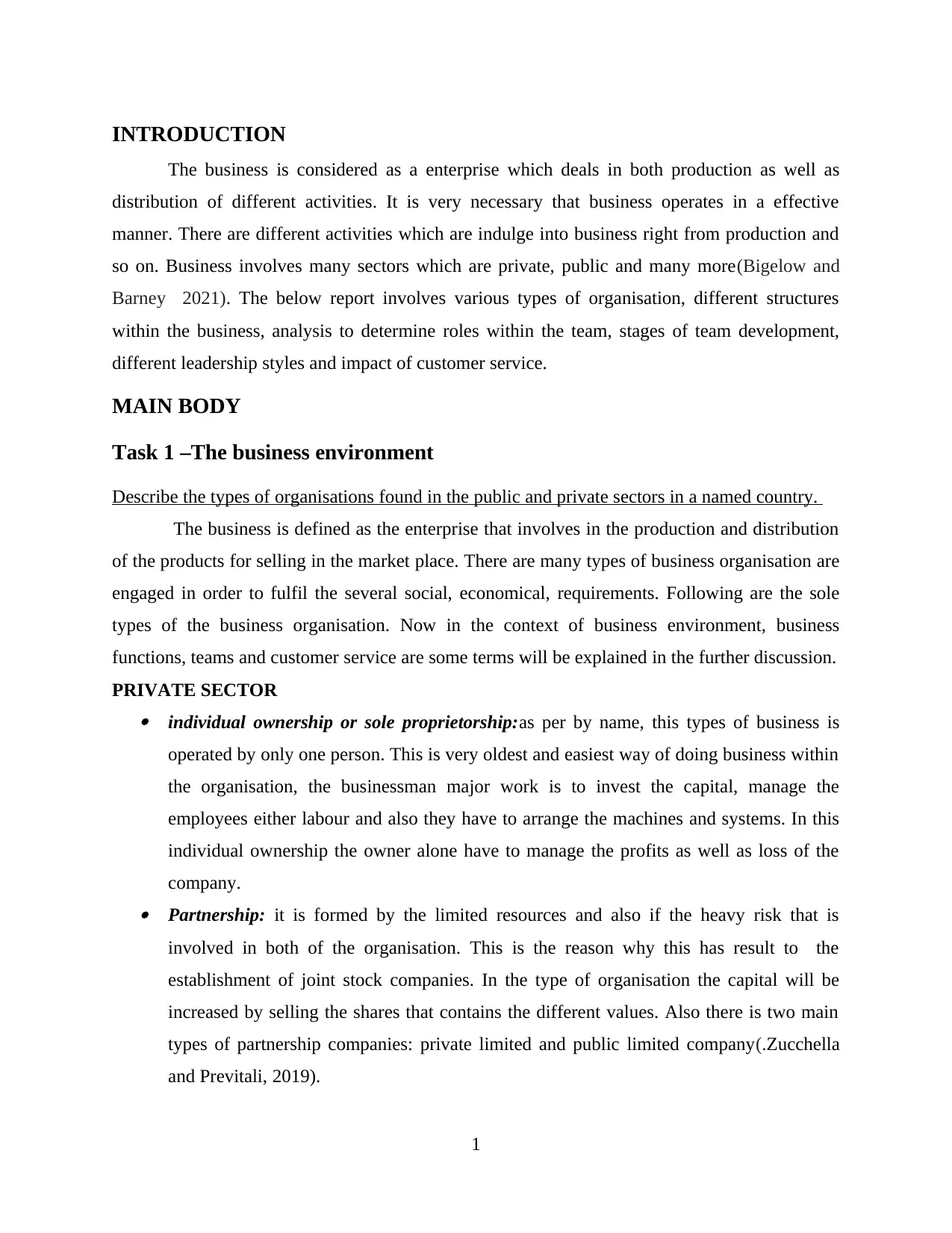
INTRODUCTION
The business is considered as a enterprise which deals in both production as well as
distribution of different activities. It is very necessary that business operates in a effective
manner. There are different activities which are indulge into business right from production and
so on. Business involves many sectors which are private, public and many more(Bigelow and
Barney 2021). The below report involves various types of organisation, different structures
within the business, analysis to determine roles within the team, stages of team development,
different leadership styles and impact of customer service.
MAIN BODY
Task 1 –The business environment
Describe the types of organisations found in the public and private sectors in a named country.
The business is defined as the enterprise that involves in the production and distribution
of the products for selling in the market place. There are many types of business organisation are
engaged in order to fulfil the several social, economical, requirements. Following are the sole
types of the business organisation. Now in the context of business environment, business
functions, teams and customer service are some terms will be explained in the further discussion.
PRIVATE SECTOR individual ownership or sole proprietorship:as per by name, this types of business is
operated by only one person. This is very oldest and easiest way of doing business within
the organisation, the businessman major work is to invest the capital, manage the
employees either labour and also they have to arrange the machines and systems. In this
individual ownership the owner alone have to manage the profits as well as loss of the
company. Partnership: it is formed by the limited resources and also if the heavy risk that is
involved in both of the organisation. This is the reason why this has result to the
establishment of joint stock companies. In the type of organisation the capital will be
increased by selling the shares that contains the different values. Also there is two main
types of partnership companies: private limited and public limited company(.Zucchella
and Previtali, 2019).
1
The business is considered as a enterprise which deals in both production as well as
distribution of different activities. It is very necessary that business operates in a effective
manner. There are different activities which are indulge into business right from production and
so on. Business involves many sectors which are private, public and many more(Bigelow and
Barney 2021). The below report involves various types of organisation, different structures
within the business, analysis to determine roles within the team, stages of team development,
different leadership styles and impact of customer service.
MAIN BODY
Task 1 –The business environment
Describe the types of organisations found in the public and private sectors in a named country.
The business is defined as the enterprise that involves in the production and distribution
of the products for selling in the market place. There are many types of business organisation are
engaged in order to fulfil the several social, economical, requirements. Following are the sole
types of the business organisation. Now in the context of business environment, business
functions, teams and customer service are some terms will be explained in the further discussion.
PRIVATE SECTOR individual ownership or sole proprietorship:as per by name, this types of business is
operated by only one person. This is very oldest and easiest way of doing business within
the organisation, the businessman major work is to invest the capital, manage the
employees either labour and also they have to arrange the machines and systems. In this
individual ownership the owner alone have to manage the profits as well as loss of the
company. Partnership: it is formed by the limited resources and also if the heavy risk that is
involved in both of the organisation. This is the reason why this has result to the
establishment of joint stock companies. In the type of organisation the capital will be
increased by selling the shares that contains the different values. Also there is two main
types of partnership companies: private limited and public limited company(.Zucchella
and Previtali, 2019).
1
⊘ This is a preview!⊘
Do you want full access?
Subscribe today to unlock all pages.

Trusted by 1+ million students worldwide
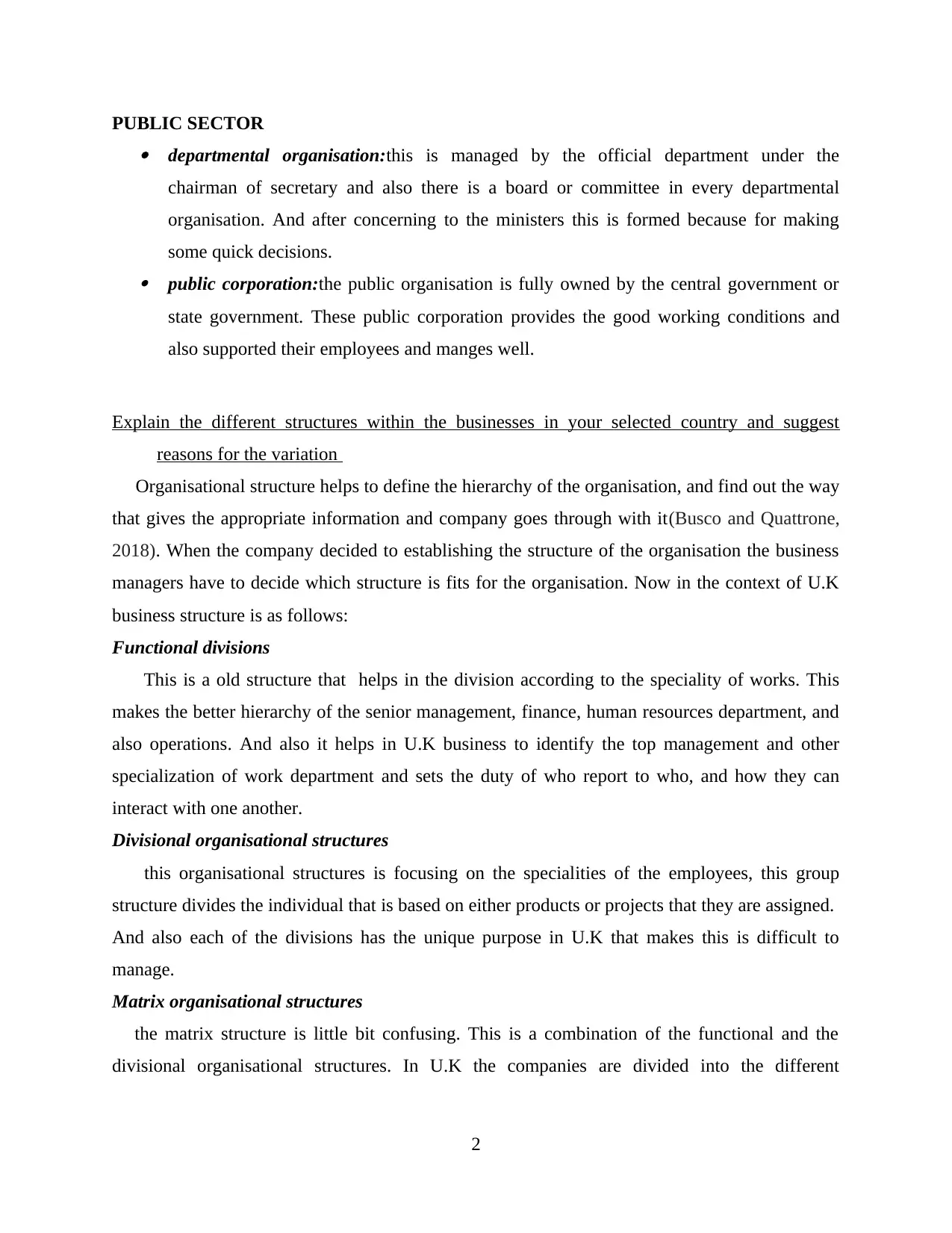
PUBLIC SECTOR departmental organisation:this is managed by the official department under the
chairman of secretary and also there is a board or committee in every departmental
organisation. And after concerning to the ministers this is formed because for making
some quick decisions. public corporation:the public organisation is fully owned by the central government or
state government. These public corporation provides the good working conditions and
also supported their employees and manges well.
Explain the different structures within the businesses in your selected country and suggest
reasons for the variation
Organisational structure helps to define the hierarchy of the organisation, and find out the way
that gives the appropriate information and company goes through with it(Busco and Quattrone,
2018). When the company decided to establishing the structure of the organisation the business
managers have to decide which structure is fits for the organisation. Now in the context of U.K
business structure is as follows:
Functional divisions
This is a old structure that helps in the division according to the speciality of works. This
makes the better hierarchy of the senior management, finance, human resources department, and
also operations. And also it helps in U.K business to identify the top management and other
specialization of work department and sets the duty of who report to who, and how they can
interact with one another.
Divisional organisational structures
this organisational structures is focusing on the specialities of the employees, this group
structure divides the individual that is based on either products or projects that they are assigned.
And also each of the divisions has the unique purpose in U.K that makes this is difficult to
manage.
Matrix organisational structures
the matrix structure is little bit confusing. This is a combination of the functional and the
divisional organisational structures. In U.K the companies are divided into the different
2
chairman of secretary and also there is a board or committee in every departmental
organisation. And after concerning to the ministers this is formed because for making
some quick decisions. public corporation:the public organisation is fully owned by the central government or
state government. These public corporation provides the good working conditions and
also supported their employees and manges well.
Explain the different structures within the businesses in your selected country and suggest
reasons for the variation
Organisational structure helps to define the hierarchy of the organisation, and find out the way
that gives the appropriate information and company goes through with it(Busco and Quattrone,
2018). When the company decided to establishing the structure of the organisation the business
managers have to decide which structure is fits for the organisation. Now in the context of U.K
business structure is as follows:
Functional divisions
This is a old structure that helps in the division according to the speciality of works. This
makes the better hierarchy of the senior management, finance, human resources department, and
also operations. And also it helps in U.K business to identify the top management and other
specialization of work department and sets the duty of who report to who, and how they can
interact with one another.
Divisional organisational structures
this organisational structures is focusing on the specialities of the employees, this group
structure divides the individual that is based on either products or projects that they are assigned.
And also each of the divisions has the unique purpose in U.K that makes this is difficult to
manage.
Matrix organisational structures
the matrix structure is little bit confusing. This is a combination of the functional and the
divisional organisational structures. In U.K the companies are divided into the different
2
Paraphrase This Document
Need a fresh take? Get an instant paraphrase of this document with our AI Paraphraser
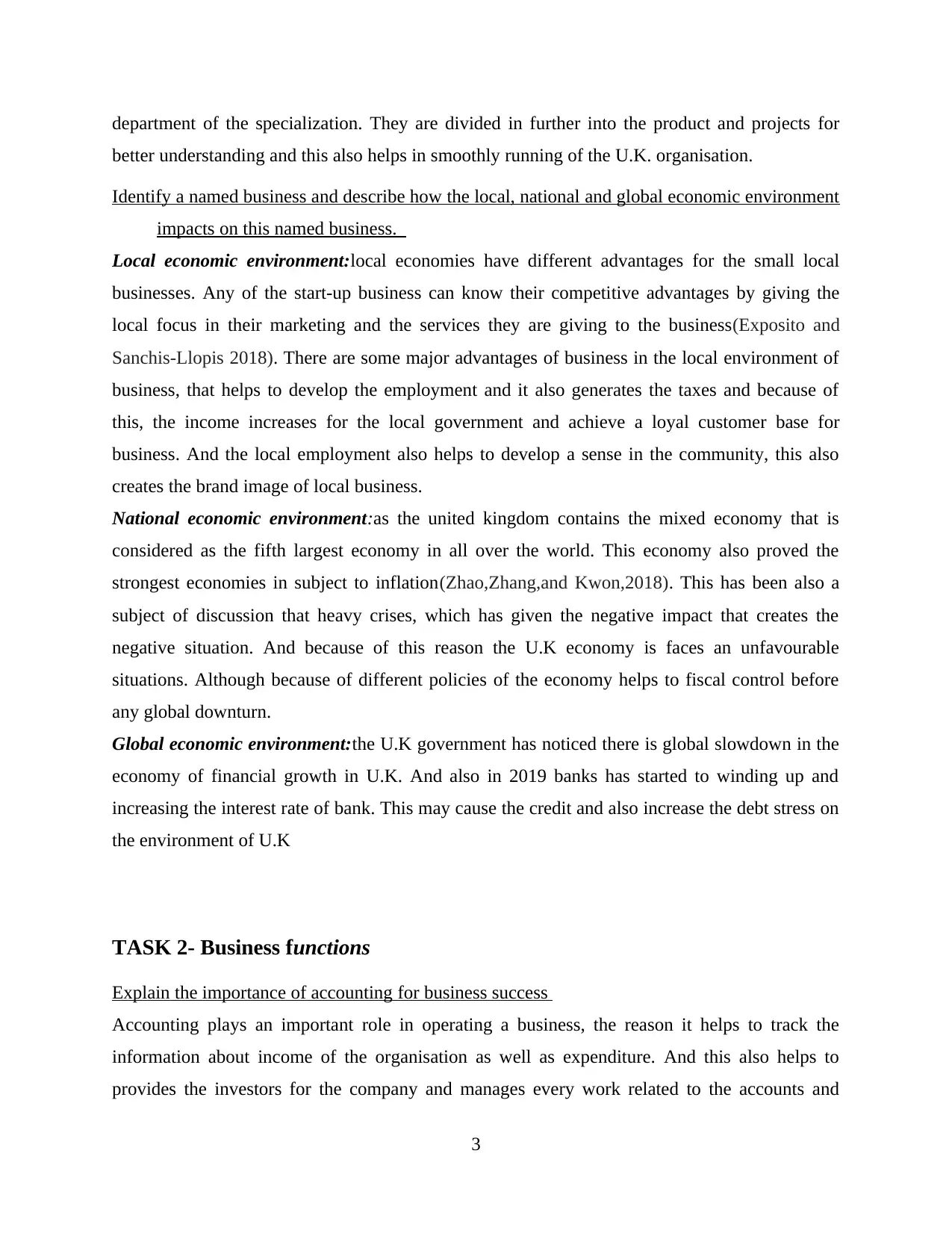
department of the specialization. They are divided in further into the product and projects for
better understanding and this also helps in smoothly running of the U.K. organisation.
Identify a named business and describe how the local, national and global economic environment
impacts on this named business.
Local economic environment:local economies have different advantages for the small local
businesses. Any of the start-up business can know their competitive advantages by giving the
local focus in their marketing and the services they are giving to the business(Exposito and
Sanchis-Llopis 2018). There are some major advantages of business in the local environment of
business, that helps to develop the employment and it also generates the taxes and because of
this, the income increases for the local government and achieve a loyal customer base for
business. And the local employment also helps to develop a sense in the community, this also
creates the brand image of local business.
National economic environment:as the united kingdom contains the mixed economy that is
considered as the fifth largest economy in all over the world. This economy also proved the
strongest economies in subject to inflation(Zhao,Zhang,and Kwon,2018). This has been also a
subject of discussion that heavy crises, which has given the negative impact that creates the
negative situation. And because of this reason the U.K economy is faces an unfavourable
situations. Although because of different policies of the economy helps to fiscal control before
any global downturn.
Global economic environment:the U.K government has noticed there is global slowdown in the
economy of financial growth in U.K. And also in 2019 banks has started to winding up and
increasing the interest rate of bank. This may cause the credit and also increase the debt stress on
the environment of U.K
TASK 2- Business functions
Explain the importance of accounting for business success
Accounting plays an important role in operating a business, the reason it helps to track the
information about income of the organisation as well as expenditure. And this also helps to
provides the investors for the company and manages every work related to the accounts and
3
better understanding and this also helps in smoothly running of the U.K. organisation.
Identify a named business and describe how the local, national and global economic environment
impacts on this named business.
Local economic environment:local economies have different advantages for the small local
businesses. Any of the start-up business can know their competitive advantages by giving the
local focus in their marketing and the services they are giving to the business(Exposito and
Sanchis-Llopis 2018). There are some major advantages of business in the local environment of
business, that helps to develop the employment and it also generates the taxes and because of
this, the income increases for the local government and achieve a loyal customer base for
business. And the local employment also helps to develop a sense in the community, this also
creates the brand image of local business.
National economic environment:as the united kingdom contains the mixed economy that is
considered as the fifth largest economy in all over the world. This economy also proved the
strongest economies in subject to inflation(Zhao,Zhang,and Kwon,2018). This has been also a
subject of discussion that heavy crises, which has given the negative impact that creates the
negative situation. And because of this reason the U.K economy is faces an unfavourable
situations. Although because of different policies of the economy helps to fiscal control before
any global downturn.
Global economic environment:the U.K government has noticed there is global slowdown in the
economy of financial growth in U.K. And also in 2019 banks has started to winding up and
increasing the interest rate of bank. This may cause the credit and also increase the debt stress on
the environment of U.K
TASK 2- Business functions
Explain the importance of accounting for business success
Accounting plays an important role in operating a business, the reason it helps to track the
information about income of the organisation as well as expenditure. And this also helps to
provides the investors for the company and manages every work related to the accounts and
3
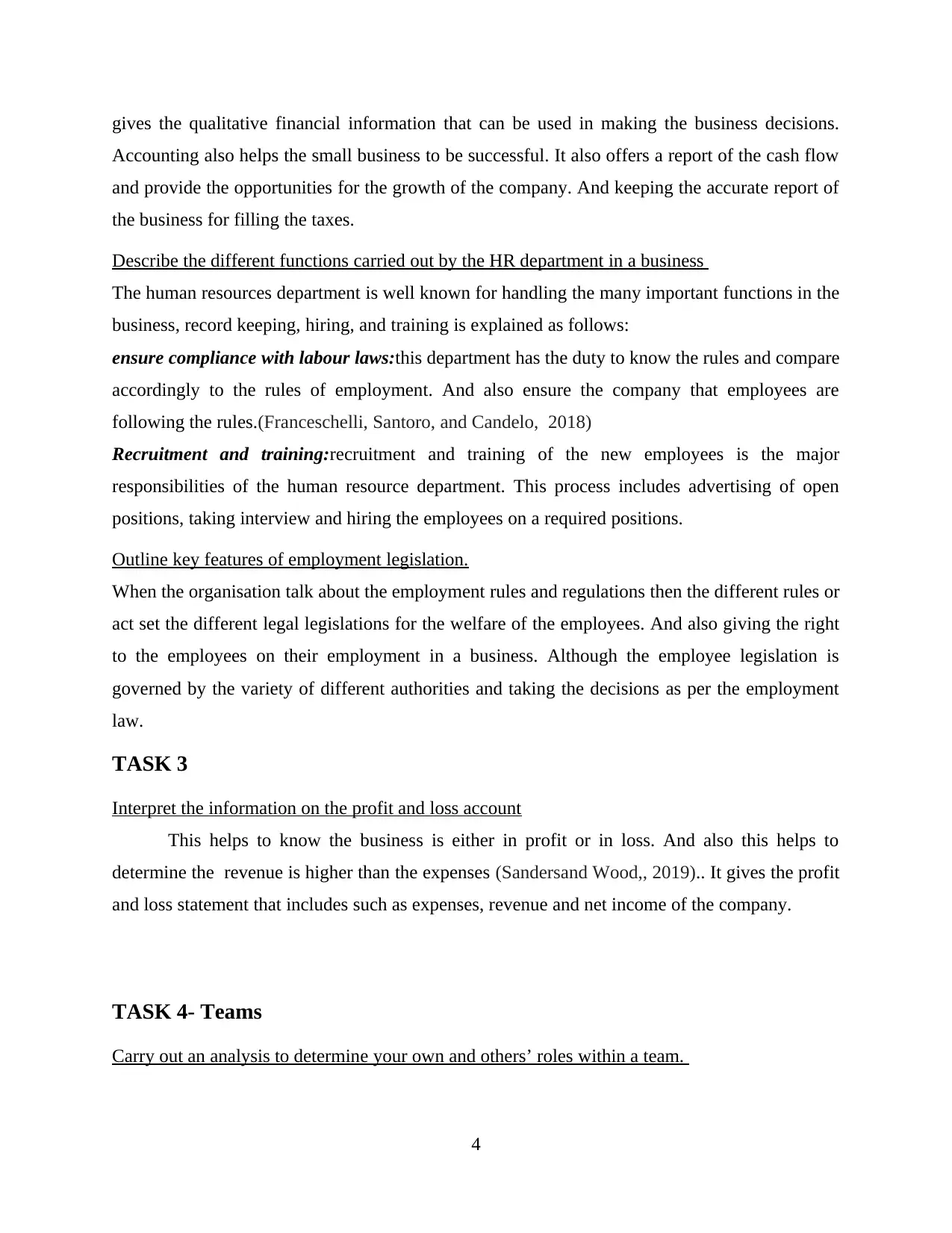
gives the qualitative financial information that can be used in making the business decisions.
Accounting also helps the small business to be successful. It also offers a report of the cash flow
and provide the opportunities for the growth of the company. And keeping the accurate report of
the business for filling the taxes.
Describe the different functions carried out by the HR department in a business
The human resources department is well known for handling the many important functions in the
business, record keeping, hiring, and training is explained as follows:
ensure compliance with labour laws:this department has the duty to know the rules and compare
accordingly to the rules of employment. And also ensure the company that employees are
following the rules.(Franceschelli, Santoro, and Candelo, 2018)
Recruitment and training:recruitment and training of the new employees is the major
responsibilities of the human resource department. This process includes advertising of open
positions, taking interview and hiring the employees on a required positions.
Outline key features of employment legislation.
When the organisation talk about the employment rules and regulations then the different rules or
act set the different legal legislations for the welfare of the employees. And also giving the right
to the employees on their employment in a business. Although the employee legislation is
governed by the variety of different authorities and taking the decisions as per the employment
law.
TASK 3
Interpret the information on the profit and loss account
This helps to know the business is either in profit or in loss. And also this helps to
determine the revenue is higher than the expenses (Sandersand Wood,, 2019).. It gives the profit
and loss statement that includes such as expenses, revenue and net income of the company.
TASK 4- Teams
Carry out an analysis to determine your own and others’ roles within a team.
4
Accounting also helps the small business to be successful. It also offers a report of the cash flow
and provide the opportunities for the growth of the company. And keeping the accurate report of
the business for filling the taxes.
Describe the different functions carried out by the HR department in a business
The human resources department is well known for handling the many important functions in the
business, record keeping, hiring, and training is explained as follows:
ensure compliance with labour laws:this department has the duty to know the rules and compare
accordingly to the rules of employment. And also ensure the company that employees are
following the rules.(Franceschelli, Santoro, and Candelo, 2018)
Recruitment and training:recruitment and training of the new employees is the major
responsibilities of the human resource department. This process includes advertising of open
positions, taking interview and hiring the employees on a required positions.
Outline key features of employment legislation.
When the organisation talk about the employment rules and regulations then the different rules or
act set the different legal legislations for the welfare of the employees. And also giving the right
to the employees on their employment in a business. Although the employee legislation is
governed by the variety of different authorities and taking the decisions as per the employment
law.
TASK 3
Interpret the information on the profit and loss account
This helps to know the business is either in profit or in loss. And also this helps to
determine the revenue is higher than the expenses (Sandersand Wood,, 2019).. It gives the profit
and loss statement that includes such as expenses, revenue and net income of the company.
TASK 4- Teams
Carry out an analysis to determine your own and others’ roles within a team.
4
⊘ This is a preview!⊘
Do you want full access?
Subscribe today to unlock all pages.

Trusted by 1+ million students worldwide
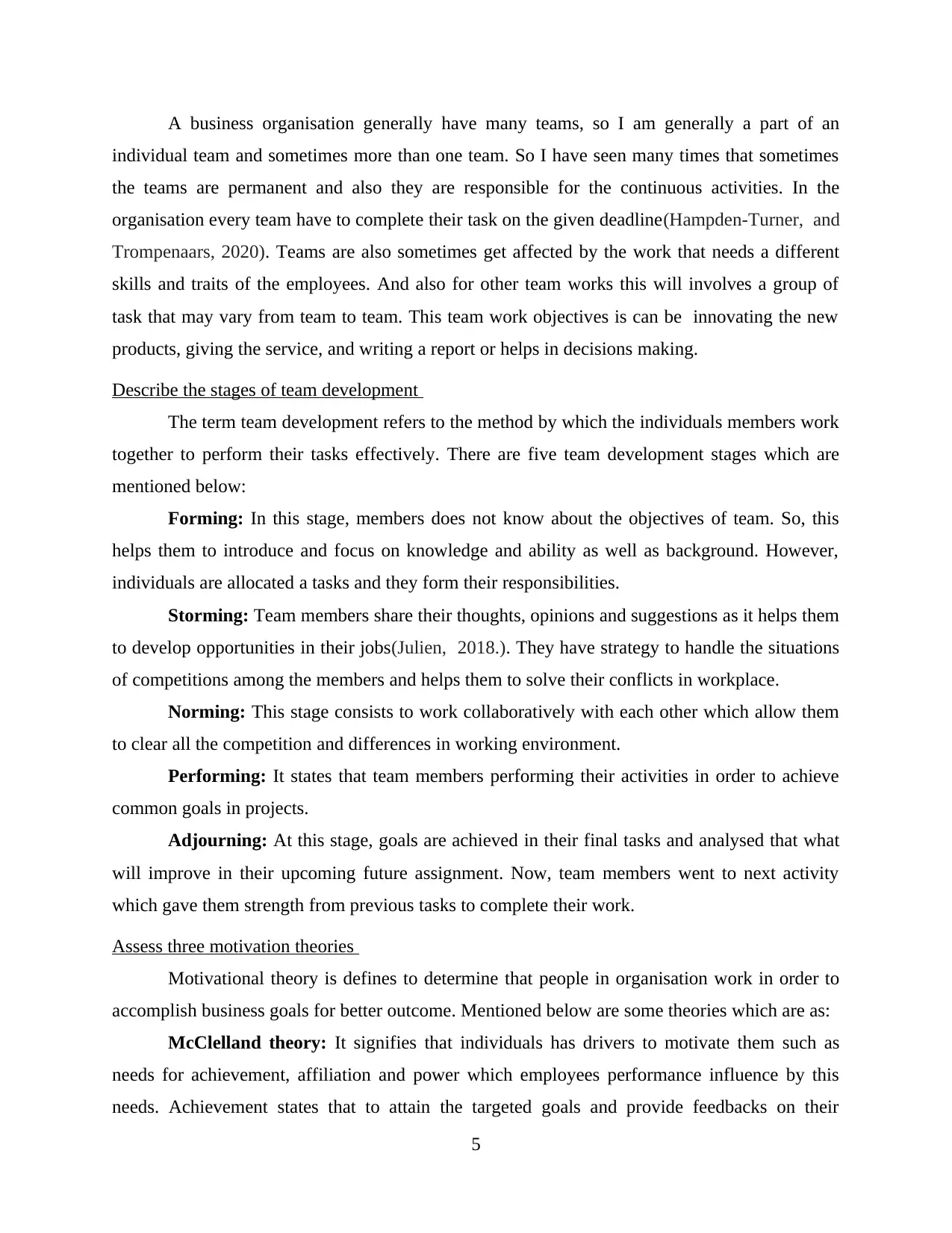
A business organisation generally have many teams, so I am generally a part of an
individual team and sometimes more than one team. So I have seen many times that sometimes
the teams are permanent and also they are responsible for the continuous activities. In the
organisation every team have to complete their task on the given deadline(Hampden-Turner, and
Trompenaars, 2020). Teams are also sometimes get affected by the work that needs a different
skills and traits of the employees. And also for other team works this will involves a group of
task that may vary from team to team. This team work objectives is can be innovating the new
products, giving the service, and writing a report or helps in decisions making.
Describe the stages of team development
The term team development refers to the method by which the individuals members work
together to perform their tasks effectively. There are five team development stages which are
mentioned below:
Forming: In this stage, members does not know about the objectives of team. So, this
helps them to introduce and focus on knowledge and ability as well as background. However,
individuals are allocated a tasks and they form their responsibilities.
Storming: Team members share their thoughts, opinions and suggestions as it helps them
to develop opportunities in their jobs(Julien, 2018.). They have strategy to handle the situations
of competitions among the members and helps them to solve their conflicts in workplace.
Norming: This stage consists to work collaboratively with each other which allow them
to clear all the competition and differences in working environment.
Performing: It states that team members performing their activities in order to achieve
common goals in projects.
Adjourning: At this stage, goals are achieved in their final tasks and analysed that what
will improve in their upcoming future assignment. Now, team members went to next activity
which gave them strength from previous tasks to complete their work.
Assess three motivation theories
Motivational theory is defines to determine that people in organisation work in order to
accomplish business goals for better outcome. Mentioned below are some theories which are as:
McClelland theory: It signifies that individuals has drivers to motivate them such as
needs for achievement, affiliation and power which employees performance influence by this
needs. Achievement states that to attain the targeted goals and provide feedbacks on their
5
individual team and sometimes more than one team. So I have seen many times that sometimes
the teams are permanent and also they are responsible for the continuous activities. In the
organisation every team have to complete their task on the given deadline(Hampden-Turner, and
Trompenaars, 2020). Teams are also sometimes get affected by the work that needs a different
skills and traits of the employees. And also for other team works this will involves a group of
task that may vary from team to team. This team work objectives is can be innovating the new
products, giving the service, and writing a report or helps in decisions making.
Describe the stages of team development
The term team development refers to the method by which the individuals members work
together to perform their tasks effectively. There are five team development stages which are
mentioned below:
Forming: In this stage, members does not know about the objectives of team. So, this
helps them to introduce and focus on knowledge and ability as well as background. However,
individuals are allocated a tasks and they form their responsibilities.
Storming: Team members share their thoughts, opinions and suggestions as it helps them
to develop opportunities in their jobs(Julien, 2018.). They have strategy to handle the situations
of competitions among the members and helps them to solve their conflicts in workplace.
Norming: This stage consists to work collaboratively with each other which allow them
to clear all the competition and differences in working environment.
Performing: It states that team members performing their activities in order to achieve
common goals in projects.
Adjourning: At this stage, goals are achieved in their final tasks and analysed that what
will improve in their upcoming future assignment. Now, team members went to next activity
which gave them strength from previous tasks to complete their work.
Assess three motivation theories
Motivational theory is defines to determine that people in organisation work in order to
accomplish business goals for better outcome. Mentioned below are some theories which are as:
McClelland theory: It signifies that individuals has drivers to motivate them such as
needs for achievement, affiliation and power which employees performance influence by this
needs. Achievement states that to attain the targeted goals and provide feedbacks on their
5
Paraphrase This Document
Need a fresh take? Get an instant paraphrase of this document with our AI Paraphraser
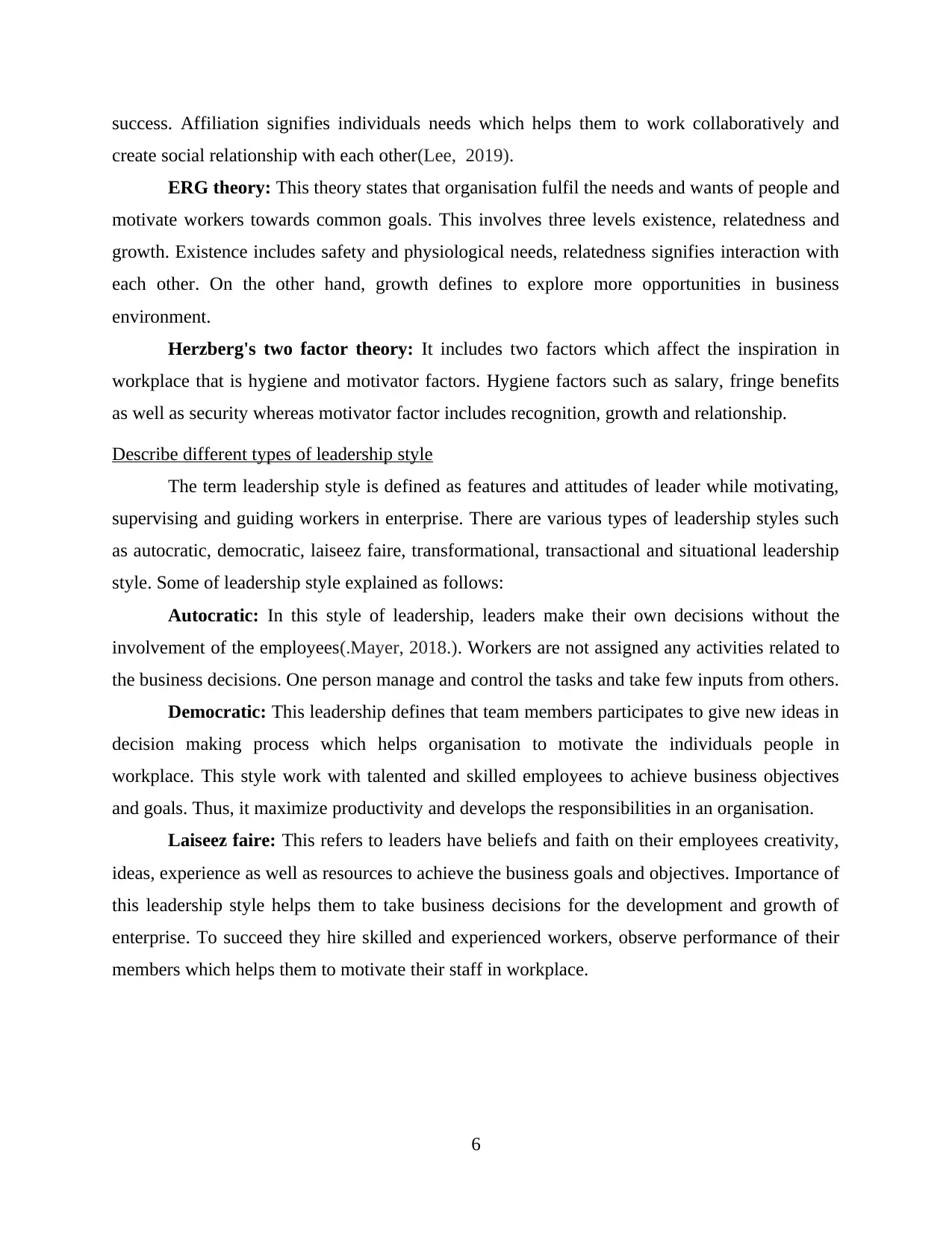
success. Affiliation signifies individuals needs which helps them to work collaboratively and
create social relationship with each other(Lee, 2019).
ERG theory: This theory states that organisation fulfil the needs and wants of people and
motivate workers towards common goals. This involves three levels existence, relatedness and
growth. Existence includes safety and physiological needs, relatedness signifies interaction with
each other. On the other hand, growth defines to explore more opportunities in business
environment.
Herzberg's two factor theory: It includes two factors which affect the inspiration in
workplace that is hygiene and motivator factors. Hygiene factors such as salary, fringe benefits
as well as security whereas motivator factor includes recognition, growth and relationship.
Describe different types of leadership style
The term leadership style is defined as features and attitudes of leader while motivating,
supervising and guiding workers in enterprise. There are various types of leadership styles such
as autocratic, democratic, laiseez faire, transformational, transactional and situational leadership
style. Some of leadership style explained as follows:
Autocratic: In this style of leadership, leaders make their own decisions without the
involvement of the employees(.Mayer, 2018.). Workers are not assigned any activities related to
the business decisions. One person manage and control the tasks and take few inputs from others.
Democratic: This leadership defines that team members participates to give new ideas in
decision making process which helps organisation to motivate the individuals people in
workplace. This style work with talented and skilled employees to achieve business objectives
and goals. Thus, it maximize productivity and develops the responsibilities in an organisation.
Laiseez faire: This refers to leaders have beliefs and faith on their employees creativity,
ideas, experience as well as resources to achieve the business goals and objectives. Importance of
this leadership style helps them to take business decisions for the development and growth of
enterprise. To succeed they hire skilled and experienced workers, observe performance of their
members which helps them to motivate their staff in workplace.
6
create social relationship with each other(Lee, 2019).
ERG theory: This theory states that organisation fulfil the needs and wants of people and
motivate workers towards common goals. This involves three levels existence, relatedness and
growth. Existence includes safety and physiological needs, relatedness signifies interaction with
each other. On the other hand, growth defines to explore more opportunities in business
environment.
Herzberg's two factor theory: It includes two factors which affect the inspiration in
workplace that is hygiene and motivator factors. Hygiene factors such as salary, fringe benefits
as well as security whereas motivator factor includes recognition, growth and relationship.
Describe different types of leadership style
The term leadership style is defined as features and attitudes of leader while motivating,
supervising and guiding workers in enterprise. There are various types of leadership styles such
as autocratic, democratic, laiseez faire, transformational, transactional and situational leadership
style. Some of leadership style explained as follows:
Autocratic: In this style of leadership, leaders make their own decisions without the
involvement of the employees(.Mayer, 2018.). Workers are not assigned any activities related to
the business decisions. One person manage and control the tasks and take few inputs from others.
Democratic: This leadership defines that team members participates to give new ideas in
decision making process which helps organisation to motivate the individuals people in
workplace. This style work with talented and skilled employees to achieve business objectives
and goals. Thus, it maximize productivity and develops the responsibilities in an organisation.
Laiseez faire: This refers to leaders have beliefs and faith on their employees creativity,
ideas, experience as well as resources to achieve the business goals and objectives. Importance of
this leadership style helps them to take business decisions for the development and growth of
enterprise. To succeed they hire skilled and experienced workers, observe performance of their
members which helps them to motivate their staff in workplace.
6
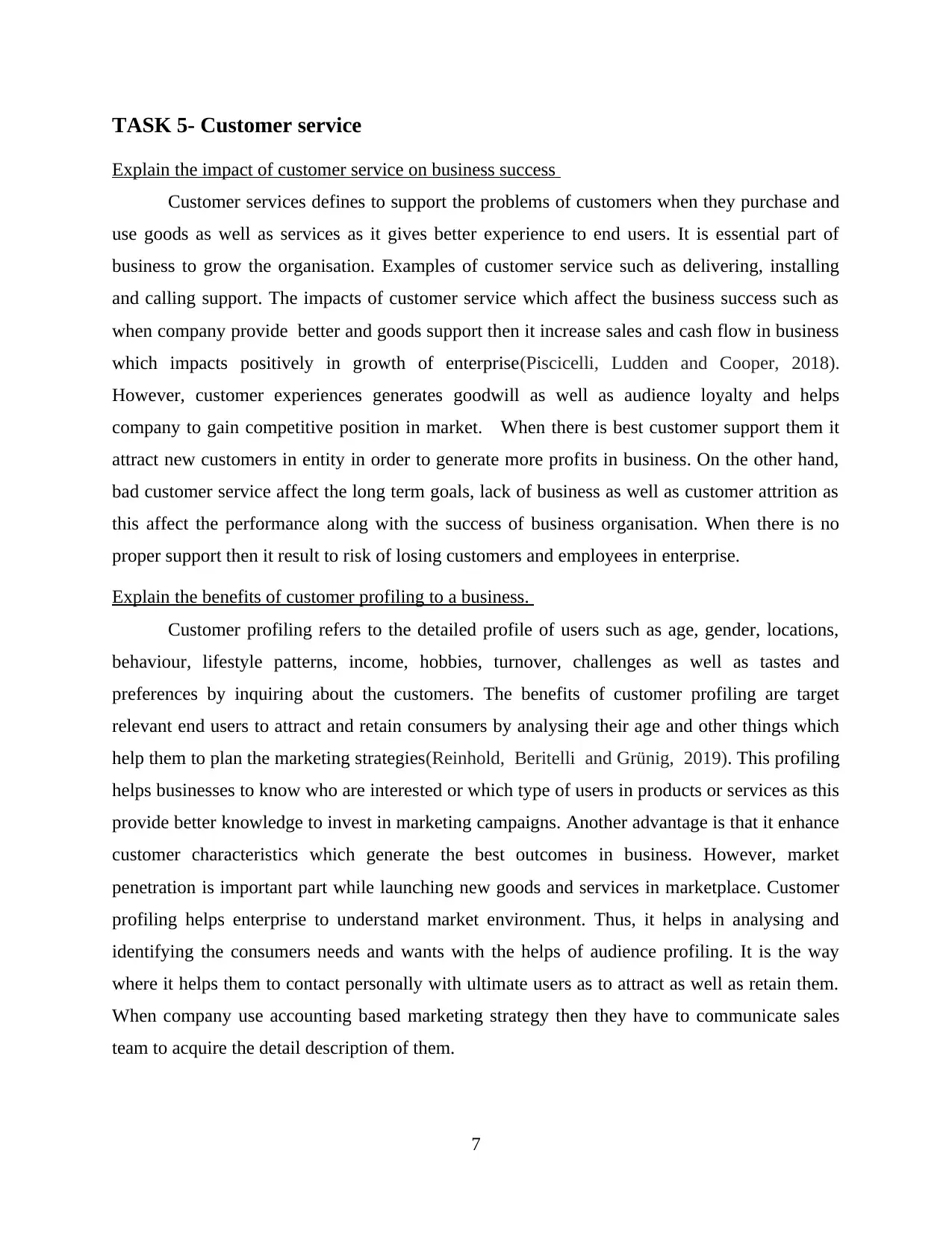
TASK 5- Customer service
Explain the impact of customer service on business success
Customer services defines to support the problems of customers when they purchase and
use goods as well as services as it gives better experience to end users. It is essential part of
business to grow the organisation. Examples of customer service such as delivering, installing
and calling support. The impacts of customer service which affect the business success such as
when company provide better and goods support then it increase sales and cash flow in business
which impacts positively in growth of enterprise(Piscicelli, Ludden and Cooper, 2018).
However, customer experiences generates goodwill as well as audience loyalty and helps
company to gain competitive position in market. When there is best customer support them it
attract new customers in entity in order to generate more profits in business. On the other hand,
bad customer service affect the long term goals, lack of business as well as customer attrition as
this affect the performance along with the success of business organisation. When there is no
proper support then it result to risk of losing customers and employees in enterprise.
Explain the benefits of customer profiling to a business.
Customer profiling refers to the detailed profile of users such as age, gender, locations,
behaviour, lifestyle patterns, income, hobbies, turnover, challenges as well as tastes and
preferences by inquiring about the customers. The benefits of customer profiling are target
relevant end users to attract and retain consumers by analysing their age and other things which
help them to plan the marketing strategies(Reinhold, Beritelli and Grünig, 2019). This profiling
helps businesses to know who are interested or which type of users in products or services as this
provide better knowledge to invest in marketing campaigns. Another advantage is that it enhance
customer characteristics which generate the best outcomes in business. However, market
penetration is important part while launching new goods and services in marketplace. Customer
profiling helps enterprise to understand market environment. Thus, it helps in analysing and
identifying the consumers needs and wants with the helps of audience profiling. It is the way
where it helps them to contact personally with ultimate users as to attract as well as retain them.
When company use accounting based marketing strategy then they have to communicate sales
team to acquire the detail description of them.
7
Explain the impact of customer service on business success
Customer services defines to support the problems of customers when they purchase and
use goods as well as services as it gives better experience to end users. It is essential part of
business to grow the organisation. Examples of customer service such as delivering, installing
and calling support. The impacts of customer service which affect the business success such as
when company provide better and goods support then it increase sales and cash flow in business
which impacts positively in growth of enterprise(Piscicelli, Ludden and Cooper, 2018).
However, customer experiences generates goodwill as well as audience loyalty and helps
company to gain competitive position in market. When there is best customer support them it
attract new customers in entity in order to generate more profits in business. On the other hand,
bad customer service affect the long term goals, lack of business as well as customer attrition as
this affect the performance along with the success of business organisation. When there is no
proper support then it result to risk of losing customers and employees in enterprise.
Explain the benefits of customer profiling to a business.
Customer profiling refers to the detailed profile of users such as age, gender, locations,
behaviour, lifestyle patterns, income, hobbies, turnover, challenges as well as tastes and
preferences by inquiring about the customers. The benefits of customer profiling are target
relevant end users to attract and retain consumers by analysing their age and other things which
help them to plan the marketing strategies(Reinhold, Beritelli and Grünig, 2019). This profiling
helps businesses to know who are interested or which type of users in products or services as this
provide better knowledge to invest in marketing campaigns. Another advantage is that it enhance
customer characteristics which generate the best outcomes in business. However, market
penetration is important part while launching new goods and services in marketplace. Customer
profiling helps enterprise to understand market environment. Thus, it helps in analysing and
identifying the consumers needs and wants with the helps of audience profiling. It is the way
where it helps them to contact personally with ultimate users as to attract as well as retain them.
When company use accounting based marketing strategy then they have to communicate sales
team to acquire the detail description of them.
7
⊘ This is a preview!⊘
Do you want full access?
Subscribe today to unlock all pages.

Trusted by 1+ million students worldwide
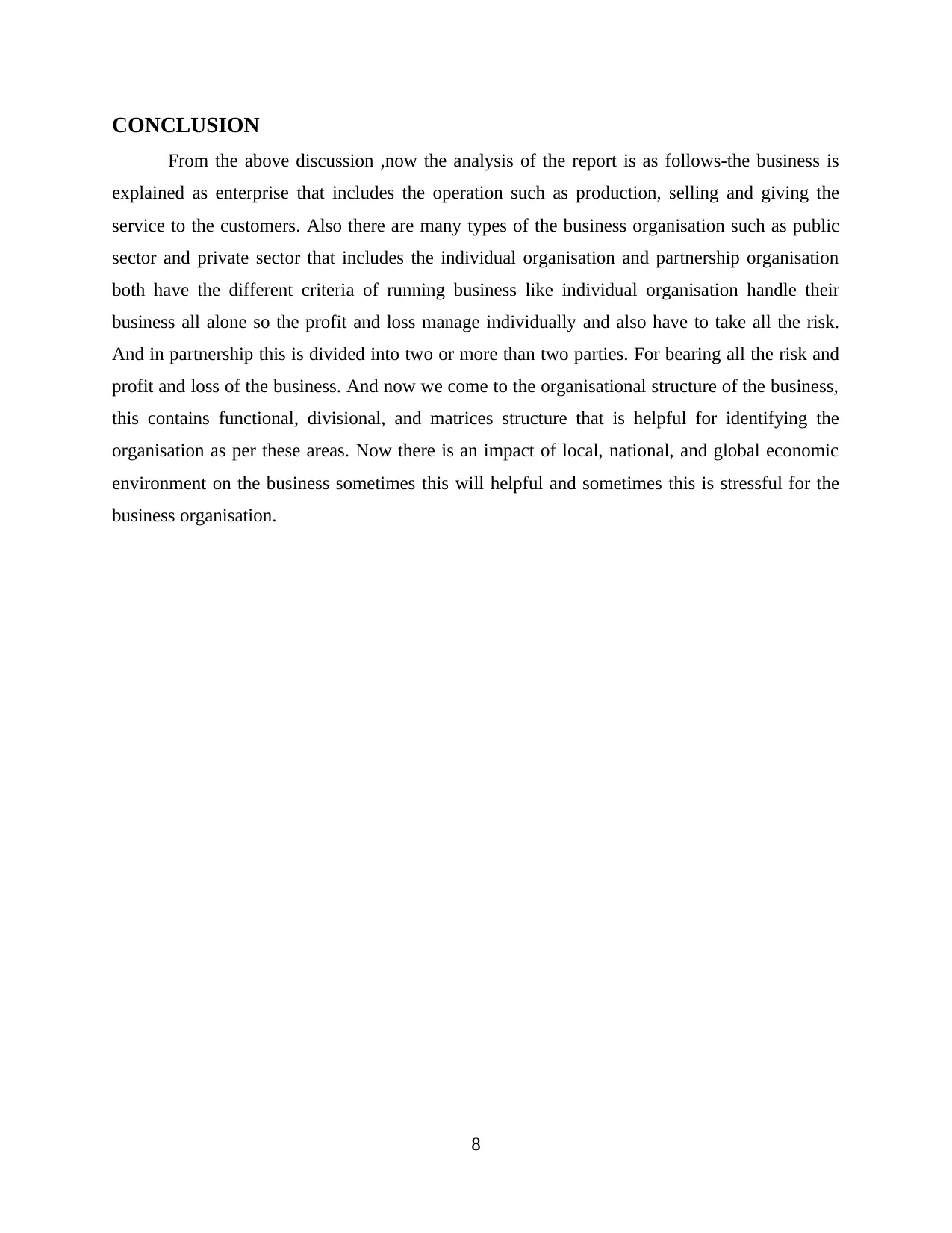
CONCLUSION
From the above discussion ,now the analysis of the report is as follows-the business is
explained as enterprise that includes the operation such as production, selling and giving the
service to the customers. Also there are many types of the business organisation such as public
sector and private sector that includes the individual organisation and partnership organisation
both have the different criteria of running business like individual organisation handle their
business all alone so the profit and loss manage individually and also have to take all the risk.
And in partnership this is divided into two or more than two parties. For bearing all the risk and
profit and loss of the business. And now we come to the organisational structure of the business,
this contains functional, divisional, and matrices structure that is helpful for identifying the
organisation as per these areas. Now there is an impact of local, national, and global economic
environment on the business sometimes this will helpful and sometimes this is stressful for the
business organisation.
8
From the above discussion ,now the analysis of the report is as follows-the business is
explained as enterprise that includes the operation such as production, selling and giving the
service to the customers. Also there are many types of the business organisation such as public
sector and private sector that includes the individual organisation and partnership organisation
both have the different criteria of running business like individual organisation handle their
business all alone so the profit and loss manage individually and also have to take all the risk.
And in partnership this is divided into two or more than two parties. For bearing all the risk and
profit and loss of the business. And now we come to the organisational structure of the business,
this contains functional, divisional, and matrices structure that is helpful for identifying the
organisation as per these areas. Now there is an impact of local, national, and global economic
environment on the business sometimes this will helpful and sometimes this is stressful for the
business organisation.
8
Paraphrase This Document
Need a fresh take? Get an instant paraphrase of this document with our AI Paraphraser
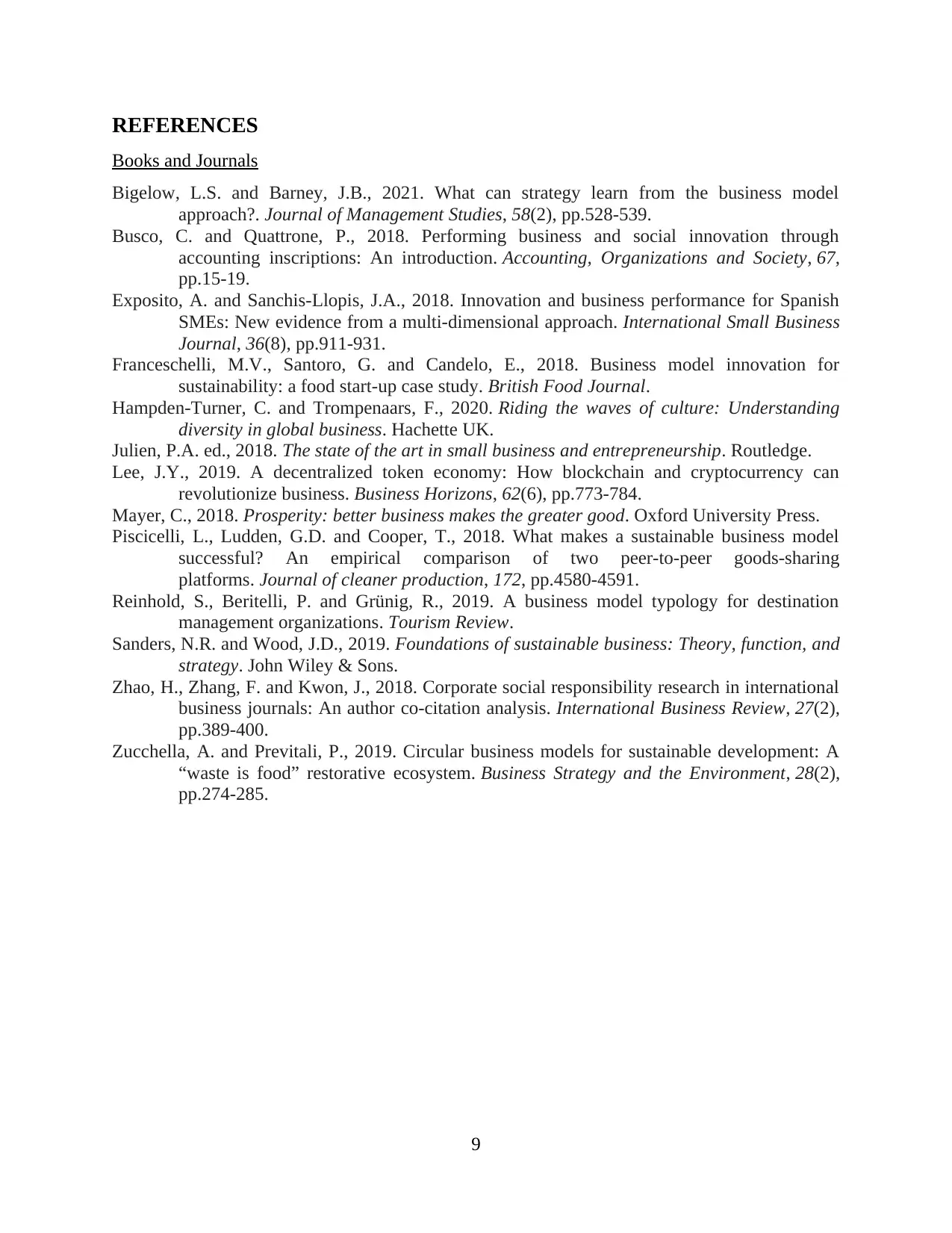
REFERENCES
Books and Journals
Bigelow, L.S. and Barney, J.B., 2021. What can strategy learn from the business model
approach?. Journal of Management Studies, 58(2), pp.528-539.
Busco, C. and Quattrone, P., 2018. Performing business and social innovation through
accounting inscriptions: An introduction. Accounting, Organizations and Society, 67,
pp.15-19.
Exposito, A. and Sanchis-Llopis, J.A., 2018. Innovation and business performance for Spanish
SMEs: New evidence from a multi-dimensional approach. International Small Business
Journal, 36(8), pp.911-931.
Franceschelli, M.V., Santoro, G. and Candelo, E., 2018. Business model innovation for
sustainability: a food start-up case study. British Food Journal.
Hampden-Turner, C. and Trompenaars, F., 2020. Riding the waves of culture: Understanding
diversity in global business. Hachette UK.
Julien, P.A. ed., 2018. The state of the art in small business and entrepreneurship. Routledge.
Lee, J.Y., 2019. A decentralized token economy: How blockchain and cryptocurrency can
revolutionize business. Business Horizons, 62(6), pp.773-784.
Mayer, C., 2018. Prosperity: better business makes the greater good. Oxford University Press.
Piscicelli, L., Ludden, G.D. and Cooper, T., 2018. What makes a sustainable business model
successful? An empirical comparison of two peer-to-peer goods-sharing
platforms. Journal of cleaner production, 172, pp.4580-4591.
Reinhold, S., Beritelli, P. and Grünig, R., 2019. A business model typology for destination
management organizations. Tourism Review.
Sanders, N.R. and Wood, J.D., 2019. Foundations of sustainable business: Theory, function, and
strategy. John Wiley & Sons.
Zhao, H., Zhang, F. and Kwon, J., 2018. Corporate social responsibility research in international
business journals: An author co-citation analysis. International Business Review, 27(2),
pp.389-400.
Zucchella, A. and Previtali, P., 2019. Circular business models for sustainable development: A
“waste is food” restorative ecosystem. Business Strategy and the Environment, 28(2),
pp.274-285.
9
Books and Journals
Bigelow, L.S. and Barney, J.B., 2021. What can strategy learn from the business model
approach?. Journal of Management Studies, 58(2), pp.528-539.
Busco, C. and Quattrone, P., 2018. Performing business and social innovation through
accounting inscriptions: An introduction. Accounting, Organizations and Society, 67,
pp.15-19.
Exposito, A. and Sanchis-Llopis, J.A., 2018. Innovation and business performance for Spanish
SMEs: New evidence from a multi-dimensional approach. International Small Business
Journal, 36(8), pp.911-931.
Franceschelli, M.V., Santoro, G. and Candelo, E., 2018. Business model innovation for
sustainability: a food start-up case study. British Food Journal.
Hampden-Turner, C. and Trompenaars, F., 2020. Riding the waves of culture: Understanding
diversity in global business. Hachette UK.
Julien, P.A. ed., 2018. The state of the art in small business and entrepreneurship. Routledge.
Lee, J.Y., 2019. A decentralized token economy: How blockchain and cryptocurrency can
revolutionize business. Business Horizons, 62(6), pp.773-784.
Mayer, C., 2018. Prosperity: better business makes the greater good. Oxford University Press.
Piscicelli, L., Ludden, G.D. and Cooper, T., 2018. What makes a sustainable business model
successful? An empirical comparison of two peer-to-peer goods-sharing
platforms. Journal of cleaner production, 172, pp.4580-4591.
Reinhold, S., Beritelli, P. and Grünig, R., 2019. A business model typology for destination
management organizations. Tourism Review.
Sanders, N.R. and Wood, J.D., 2019. Foundations of sustainable business: Theory, function, and
strategy. John Wiley & Sons.
Zhao, H., Zhang, F. and Kwon, J., 2018. Corporate social responsibility research in international
business journals: An author co-citation analysis. International Business Review, 27(2),
pp.389-400.
Zucchella, A. and Previtali, P., 2019. Circular business models for sustainable development: A
“waste is food” restorative ecosystem. Business Strategy and the Environment, 28(2),
pp.274-285.
9
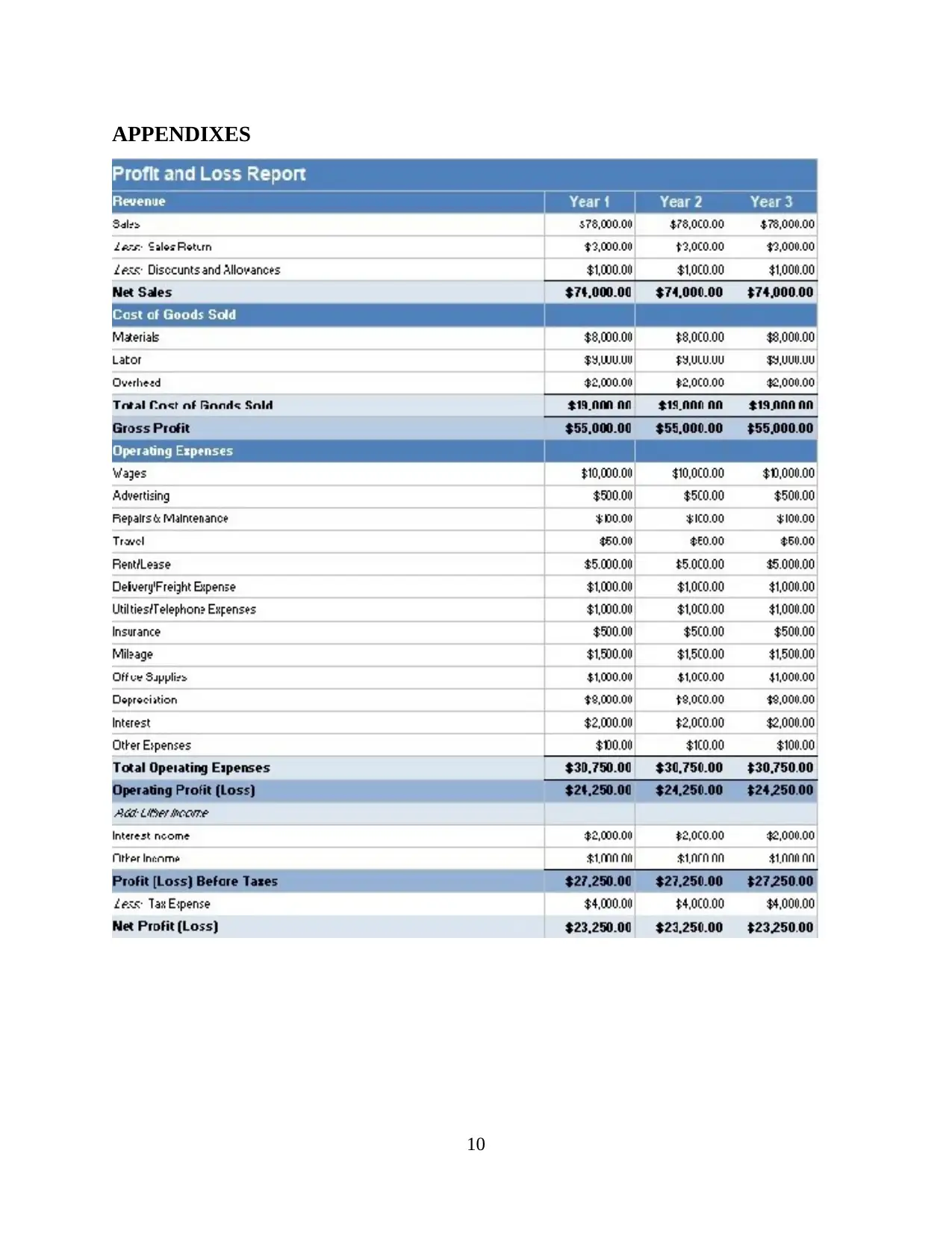
APPENDIXES
10
10
⊘ This is a preview!⊘
Do you want full access?
Subscribe today to unlock all pages.

Trusted by 1+ million students worldwide
1 out of 12
Related Documents
Your All-in-One AI-Powered Toolkit for Academic Success.
+13062052269
info@desklib.com
Available 24*7 on WhatsApp / Email
![[object Object]](/_next/static/media/star-bottom.7253800d.svg)
Unlock your academic potential
Copyright © 2020–2025 A2Z Services. All Rights Reserved. Developed and managed by ZUCOL.





